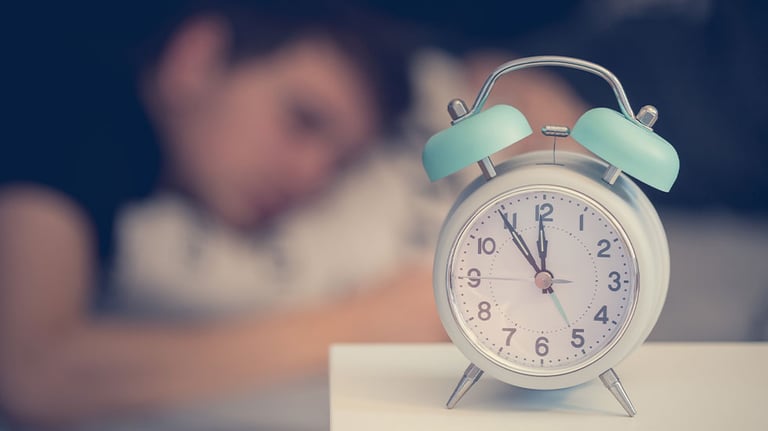How to Handle Daylight Saving Time Like a Pro
9 tips to help you ease into daylight saving time and avoid the Monday morning blues


When it’s time to move your clocks forward in the spring (beginning daylight saving time) or fall back in the fall (ending daylight saving time), losing or gaining an hour can really disrupt your sleep and schedule. A one-hour change may not seem like a lot, but it can be difficult to adjust during the week after the time change.
Your internal clock has to catch up to the change, but here are some best practices for taking it on:
First, how does daylight saving time affect your health?
Surveys from the American Academy of Sleep Medicine (AASM) have found that more than 60% of Americans would prefer to eliminate daylight saving time. That’s because it can have a variety of impacts on our health. For example:
- The change is associated with heightened risk of mood disturbances, hospital admissions, and elevated production of inflammatory markers in response to stress.
- Less daylight can negatively affect mental health, especially for those who work during the day, exacerbating mood disorders such as depression and anxiety.
- Exposing ourselves to more sunlight (when we spring ahead an hour) can make it harder to fall asleep. Less sleep means more health risks like decrease in cardiovascular health, increase in diabetes and obesity, lower cognitive performance, and more.

How long does it take our body to adjust to daylight saving?
According to the AASM, it can take the body five to seven days to adjust to daylight saving time.
9 tips for avoiding daylight saving slumps
1. Prepare ahead of time
Beginning a week or two before you change your clock, start going to bed 15 minutes earlier each day until your bedtime is 60 or 90 minutes earlier. This way, you can ease into the one-hour change and your body won’t experience such a harsh disruption. For example, if you typically go to bed at 11 p.m., try going to bed at 10 p.m. instead.
2. Maintain your sleep schedule
Once the clocks do change, make sure you’re getting at least seven to nine hours of sleep each night. Even though the day will be shorter, setting your bedtime accordingly and getting the full amount of rest will help your body adjust better. Don’t stay up later or sleep in longer just because of the change. This includes the weekends!

3. Increase vitamin D
Natural light can help increase serotonin in the brain, which helps you wake up naturally in the morning. Increase your exposure to sunlight early in the morning, or take an afternoon or evening walk to get a little more sunshine.
4. Don’t take naps
Getting a little shut-eye during the day is tempting, especially if you’re feeling tired and sluggish. However, avoiding naps is key for adjusting to the time change since daytime naps can make it more difficult to get a good night’s sleep. If you do need a nap, keep it short (no longer than 20 minutes) and do it early in the day.
5. Avoid eating late
Eating too close to bedtime can actually disrupt your sleep at any time, especially during the daylight savings transition. Plan to finish all meals and snacks at least two to three hours before bedtime. Avoid caffeine intake and alcohol consumption too late in the evening as well.
That said, do stock up on foods that nourish during meal time. Fish, nuts, and other protein-rich foods can help you feel full and give your body the natural energy it needs to function.

6. Skip the late-night workout
Before bed, you should slow your body down. Raising your body’s core temperature can make it harder to sleep, so avoid heavy workouts within a few hours of bedtime. Get your exercise minutes in earlier in the day so your body has time to cool down before bed.
7. Trick your brain
Your brain looks for visual cues to know what time it is. Change the time on your wristwatch or wall clock to be 15 minutes ahead for a few days before the change to provide that visual cue.

8. Set up your environment
Make sure your bedroom environment is conducive to good sleep:
- Put away electronic devices at least an hour before you go to sleep. The blue light emitted by your cell phone screen restrains the production of melatonin, which is the hormone that controls your sleep-wake cycle, making it more difficult to fall asleep and wake up the next day.
- Create a bedtime routine. This can be taking a bath, reading a book, putting on comfy pajamas, drinking caffeine-free tea, or something else that helps get your mind in a restful, relaxed space and signals it’s time for bed.
- Make sure your bedroom is dark, quiet, and cool. It’s suggested to keep your room between 60 and 68 degrees Fahrenheit for the most comfortable sleep. If you don’t like silence, try a fan or noise machine. Consider light-blocking blinds or curtains, or use ear plugs and/or an eye mask.
- Use the bed only for sleeping. Working, watching TV, reading, and other activities in bed can confuse your brain, so when it’s actually bedtime, it might feel ready to be creative or productive. Only using the bed for sleeping helps the mind adjust to the habit, which can help you fall asleep easier.
9. Socialize
When the clocks fall back, it starts getting darker earlier and stays darker longer. Winter can bring a sense of isolation to many, sometimes leading to seasonal depression. Try to stay socially engaged. Join a club, find people who share a hobby, or check out a group exercise class. When you feel socially and emotionally engaged, your body will feel healthier and you’ll experience an increase in serotonin and other hormones that can help you sleep.
